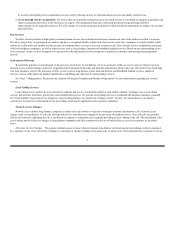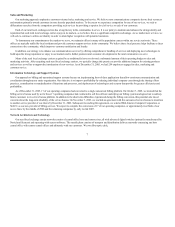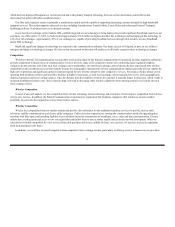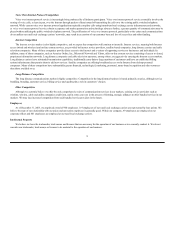FairPoint Communications 2005 Annual Report Download - page 16
Download and view the complete annual report
Please find page 16 of the 2005 FairPoint Communications annual report below. You can navigate through the pages in the report by either clicking on the pages listed below, or by using the keyword search tool below to find specific information within the annual report.
any requesting communications carrier at any technically feasible point; (ii) unbundle and provide nondiscriminatory access to network elements such as
local loops, switches and transport facilities, at nondiscriminatory rates and on nondiscriminatory terms and conditions; (iii) offer their retail services for
resale at wholesale rates; (iv) provide reasonable notice of changes in the information necessary for transmission and routing of services over the incumbent
telephone company’s facilities or in the information necessary for interoperability; and (v) provide, at rates, terms and conditions that are just, reasonable and
nondiscriminatory, for the physical co-location of equipment necessary for interconnection or access to unbundled network elements at the premises of the
incumbent telephone company. Competitors are required to compensate the incumbent local exchange carrier for the cost of providing these interconnection
services. However, pursuant to the Telecommunications Act, rural telephone companies, including our rural local exchange carriers, are automatically exempt
from these additional incumbent telephone company requirements. The exemption remains effective until an incumbent rural local telephone company receives
a bona fide request for these additional interconnection services and the applicable state authority determines whether the request is not unduly economically
burdensome, technically feasible, and consistent with the universal service objectives set forth in the Telecommunications Act. This exemption remains
effective for all of our incumbent local telephone operations, except in Florida where the legislature has determined that all incumbent local exchange carriers are
required to provide the additional interconnection services as prescribed in the Telecommunications Act. If a request for any of these additional interconnection
services is filed by a potential competitor with respect to one of our other operating territories, we are likely to ask the relevant state regulatory commission to
retain the exemption. If a state regulatory commission rescinds such exemption in whole or in part and if the state regulatory commission does not allow us
adequate compensation for the costs of providing the interconnection, our costs would significantly increase, we would face new competitors in that state and
we could suffer a significant loss of customers and resulting declines in our revenues. In addition, we could incur additional administrative and regulatory
expenses as a result of the interconnection requirements.
Promotion of Universal Service
The payments received by our rural local exchange carriers from the Universal Service Fund are intended to support the high cost of our operations in
rural markets. Payments from the high cost loop component of the Universal Service Fund represented 8% of our revenues for the year ended December 31,
2005. Under current Federal Communications Commission regulations, the total Universal Service Fund available to all rural local telephone companies,
including our 28 rural local exchange carrier subsidiaries, is subject to a cap. In any given year, the cap may or may not be reached. In any year where the cap
is reached, the per access line rate at which we can recover Universal Service Fund payments may decrease. In addition, the consideration of changes in the
federal rules governing the distribution of Universal Service Fund is pending before the Federal Communications Commission. If our rural local exchange
carriers were unable to receive Universal Service Fund payments, or if such payments were reduced, many of our rural local exchange carriers would be
unable to operate as profitably as they have historically in the absence of our implementation of increases in charges for other services. Moreover, if we raise
prices for services to offset loss of Universal Service Fund payments, the increased pricing of our services may disadvantage us competitively in the
marketplace, resulting in additional potential revenue loss. Payments from the Universal Service Fund fluctuate based upon our average cost per loop
compared with the national average cost per loop. For example, if the national average cost per loop increases and our operating costs (and average cost per
loop) remain constant or decrease, the payments we receive from the Universal Service Fund would decline. Conversely, if the national average cost per loop
decreases and our operating costs (and average cost per loop) remain constant or increase, the payments we receive from the Universal Service Fund would
increase. Over the past year, the national average cost per loop in relation to our average cost per loop has increased and we believe the national average cost per
loop will
14
























